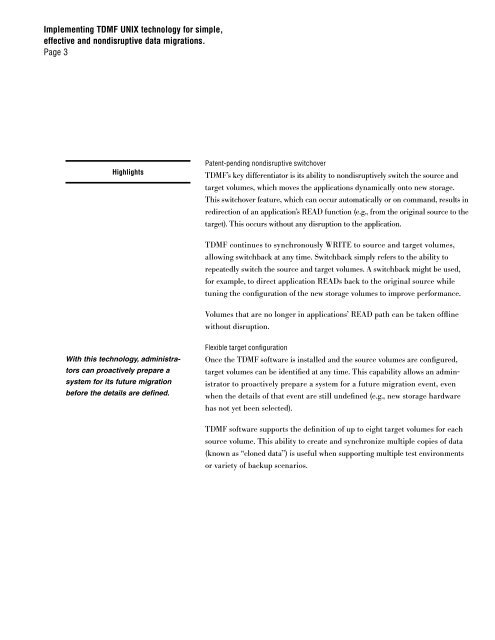Implementing TDMF UNIX technology for simple, effective and ... - IBM
Implementing TDMF UNIX technology for simple, effective and ... - IBM Implementing TDMF UNIX technology for simple, effective and ... - IBM
Implementing TDMF UNIX technology for simple, effective and nondisruptive data migrations. Page 2 Contents 2 Introduction 2 TDMF UNIX capabilities 6 TDMF architecture 8 TDMF UNIX phases 12 TDMF performance considerations 15 Tips for conducting large migrations 18 Comparison with volume manager mirroring 19 Other Softek migration solutions 19 Platform support 20 Summary Introduction Softek TDMF UNIX ® technology is host-based software that moves data at the block level between logical volumes (file system managed or raw vol- umes) without interrupting the applications that read/write to those volumes. Transparent Data Migration Facility (TDMF) software works with any volume manager, file system or database raw volume. This software is ideal for the following types of local data migrations: • Technology refresh, especially in heterogeneous or high-availability environments • DAS to SAN migrations • Implementing tiered storage • Consolidating storage locally • Dynamic data movement to fix performance problems (e.g., moving volumes from storage hot spots) TDMF UNIX capabilities Simple, easy installation The distinct value of the TDMF UNIX solution is its simplicity—three components designed to execute flawlessly together. It is designed to be simple to install, simple to use and simple to maintain.
Implementing TDMF UNIX technology for simple, effective and nondisruptive data migrations. Page 3 Highlights With this technology, administrators can proactively prepare a system for its future migration before the details are defined. Patent-pending nondisruptive switchover TDMF’s key differentiator is its ability to nondisruptively switch the source and target volumes, which moves the applications dynamically onto new storage. This switchover feature, which can occur automatically or on command, results in redirection of an application’s READ function (e.g., from the original source to the target). This occurs without any disruption to the application. TDMF continues to synchronously WRITE to source and target volumes, allowing switchback at any time. Switchback simply refers to the ability to repeatedly switch the source and target volumes. A switchback might be used, for example, to direct application READs back to the original source while tuning the configuration of the new storage volumes to improve performance. Volumes that are no longer in applications’ READ path can be taken offline without disruption. Flexible target configuration Once the TDMF software is installed and the source volumes are configured, target volumes can be identified at any time. This capability allows an administrator to proactively prepare a system for a future migration event, even when the details of that event are still undefined (e.g., new storage hardware has not yet been selected). TDMF software supports the definition of up to eight target volumes for each source volume. This ability to create and synchronize multiple copies of data (known as “cloned data”) is useful when supporting multiple test environments or variety of backup scenarios.
- Page 1: IBM Global Technology Services Dece
- Page 5 and 6: Implementing TDMF UNIX technology f
- Page 7 and 8: Implementing TDMF UNIX technology f
- Page 9 and 10: Implementing TDMF UNIX technology f
- Page 11 and 12: Implementing TDMF UNIX technology f
- Page 13 and 14: Implementing TDMF UNIX technology f
- Page 15 and 16: Implementing TDMF UNIX technology f
- Page 17 and 18: Implementing TDMF UNIX technology f
- Page 19 and 20: Implementing TDMF UNIX technology f
<strong>Implementing</strong> <strong>TDMF</strong> <strong>UNIX</strong> <strong>technology</strong> <strong>for</strong> <strong>simple</strong>,<br />
<strong>effective</strong> <strong>and</strong> nondisruptive data migrations.<br />
Page 3<br />
Highlights<br />
With this <strong>technology</strong>, administrators<br />
can proactively prepare a<br />
system <strong>for</strong> its future migration<br />
be<strong>for</strong>e the details are defined.<br />
Patent-pending nondisruptive switchover<br />
<strong>TDMF</strong>’s key differentiator is its ability to nondisruptively switch the source <strong>and</strong><br />
target volumes, which moves the applications dynamically onto new storage.<br />
This switchover feature, which can occur automatically or on comm<strong>and</strong>, results in<br />
redirection of an application’s READ function (e.g., from the original source to the<br />
target). This occurs without any disruption to the application.<br />
<strong>TDMF</strong> continues to synchronously WRITE to source <strong>and</strong> target volumes,<br />
allowing switchback at any time. Switchback simply refers to the ability to<br />
repeatedly switch the source <strong>and</strong> target volumes. A switchback might be used,<br />
<strong>for</strong> example, to direct application READs back to the original source while<br />
tuning the configuration of the new storage volumes to improve per<strong>for</strong>mance.<br />
Volumes that are no longer in applications’ READ path can be taken offline<br />
without disruption.<br />
Flexible target configuration<br />
Once the <strong>TDMF</strong> software is installed <strong>and</strong> the source volumes are configured,<br />
target volumes can be identified at any time. This capability allows an administrator<br />
to proactively prepare a system <strong>for</strong> a future migration event, even<br />
when the details of that event are still undefined (e.g., new storage hardware<br />
has not yet been selected).<br />
<strong>TDMF</strong> software supports the definition of up to eight target volumes <strong>for</strong> each<br />
source volume. This ability to create <strong>and</strong> synchronize multiple copies of data<br />
(known as “cloned data”) is useful when supporting multiple test environments<br />
or variety of backup scenarios.



